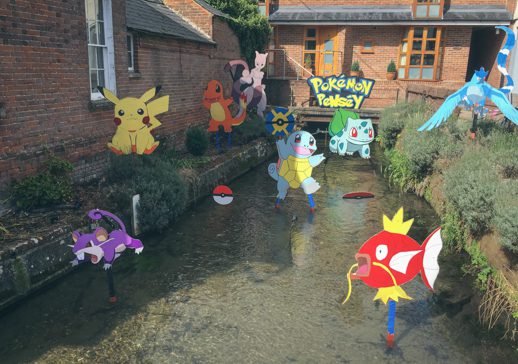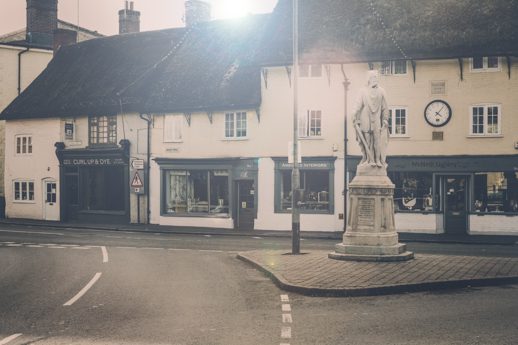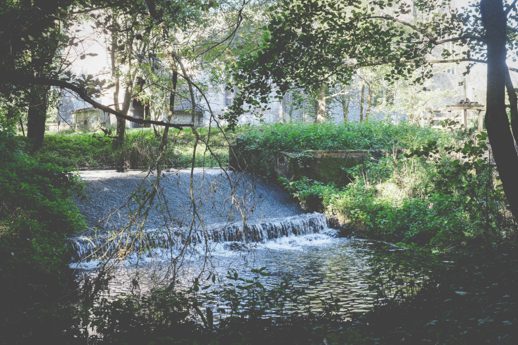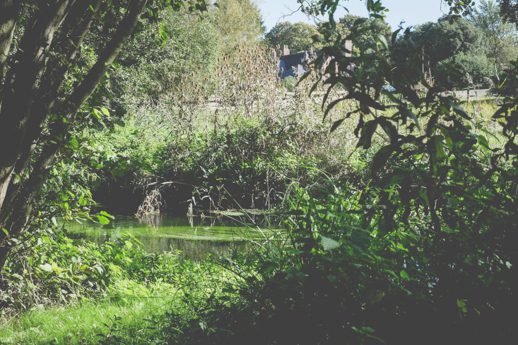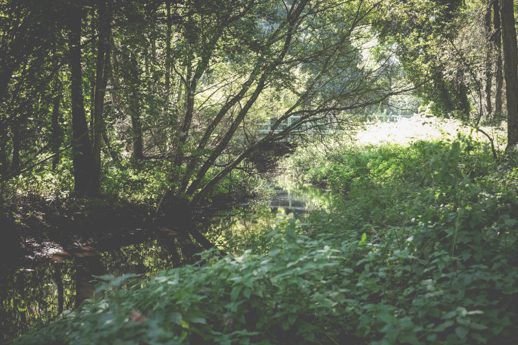Words and pictures: Malcolm Anderson
It’s Sunday morning as I arrive in the village of Pewsey, or Pevisigge to give it its Saxon name (simply translated as ‘Pev’s Island’).
A series of shiny four-wheel drives pull up outside the Spar and floppy haired men in their gangland colours of checked shirts and red cords dash in for copies of the Times and Telegraph, then speed off.
It is quite literally the morning after the night before in Pewsey and there are telltale signs of a night of revelry everywhere: a speaker system, now silent, stands wrapped in plastic bags chained to a lamppost. Strings of decorative lights lie sleeping in coils, spooled up, not needed now until Christmas. A little pile of vomit lies draped over pavement and kerb like a skittle-coloured dali clock.
Last night marked the end of the Pewsey Carnival, a two-week celebration that culminates in an eclectic, noisy, drunken procession through the village in what are best described loosely as wheelbarrow-floats. The carnival dates back to 1898 and proudly claims to be the oldest carnival in Wiltshire. In reality it goes back a long way further than that.
King Alfred once owned the village and much of the vale around it and local legend has it that when he trotted off to war he left his wife behind for the people of Pewsey to look after. When he returned safely, and his wife was still in one piece, he granted the village the right to hold an annual feast, which is now held bi-annually and rolled up into the carnival. Brian Vesey-Fitzgerald remembers the feast thus
“…a great local event with a procession¬¬¬—farm carts with tableaux, bands and dancing, coconut shies and swings and so forth. There was more than a little drinking that night, and perhaps a fight or two, and a good deal of indiscriminate love-making, and much jollity.”
Sounds good to me. And looking around me at the broken remains of a jolly good night out, I’m struck by the thought that despite all our technological advances, and indeed perhaps in spite of modern life, not much has really changed over the last sixty-five years.
A statue of King Alfred has stood here on the junction of the A345 and B3087 since 1913, stony faced with sword in hand. Studiously ignoring the adroitly named Curl up and Dye hairdressers salon, the busy roads and the annual carnival processions. Looking around the village which, being honest is a small town in all but name, there is little that Alfred would recognise of his former home. Perhaps only the Deane Water – the Eastern arm of the Avon as it flows through the town – is truly constant, yet even here the river feels constrained, lined by concrete and forced into vertically-sided channels. Its fine gravel bottom is silt-covered and the clear water trickles over a largely lifeless bed. This morning, as the river tumbles beneath the old buildings on the High Street, it suffers the added indignity of being full of large wooden Pokémon figures, a leftover from last night.
It’s hardly the beautiful stream I’m searching for. So, increasingly twitchy at being surrounded by civilization, I shoulder my small pack and start wandering downstream as close to the course of the river as I can get.
This proves much harder than I’d anticipated as the river disappears quickly into private gardens, reappearing in tantalizing glimpses under fences and over hedges. I’m surprised I don’t attract more attention from Wiltshire’s finest as they pass me slowly by (more than once), kneeling with my wader-clad arse in the air to peer under fences and balancing precariously one-footed on fence posts as I am.
Next to the Esso garage on the edge of the village the road kicks around a left-hand bend and the river appears once more, ignored by the busy lives of most Wiltshire-folk, hemmed in between an iron-railing-topped brick wall and a grey-walled industrial unit.
As it passes under the thrumming sun-warmed tarmac however, the river steps through the fur coats in the back of the wardrobe and emerges into an entirely different world.
The river tumbles off its concrete sill into a small pool, perhaps eight feet across and at most, three feet deep. In the back corner of the pool sits an old pollarded willow, its leaves yellowing in the late summer sunshine and letting in the autumn sun like a colander. An upside down traffic cone sits incongruously, wedged tight up against the blood red root ball. The shifting current curves around this artificial plastic reef, slides over the faded red cone and bunches up like loose stockings. The shifting shards of light penetrating the willow canopy are fractured by the combination of ruffled water, the reflective band on the cone and form shifting will-o’-the-wisps which dance gleefully above the surface.
Past the willow, the river pushes under a single strand of old barbed wire and out into the sunshine of open water-meadow. Sadly, there’s no public access into the meadow and I can’t see a way to sneakily squeeze through the hedge so I take to the road and head down the long straight stretch towards the Manningfords.
In the multi-folded shadow of Denny Sutton Hipend, a quite astonishing piece of steep-sided chalk gouged deeply by a concertina of ancient fields, I turn off the A345 and wander in towards East Sharcott and the river. I stand for a moment or two on the small bridge over the river just past New Farm and let the pull of the water draw me back in. Much the same feeling as that of standing on a cliff edge, when you feel gravity’s subtle, siren-like voice luring forwards and over.
Upstream of me, around wooded meanders sits Pewsey sewage treatment works, an industrial compound surrounded by wire. Its clinker and concrete heart whirring and clanking away, already dealing with the food and drink excesses of carnival night in town.
Just along the road a little further, a small stream cuts under the road, bringing a flush of new water to the Deane Water, adding to its credence as a fledgling river rather than a small brook. This small pulse of fresh water has run down from the edge of the chalk ridge in the shadow of Picked Hill, from the Wilcot withy beds lying alongside the Kennet & Avon canal.
The Manningfords – Abbot, Bruce and Bohune – Sit clustered along the course of the river, seemingly in a random layout, connected by a network of footpaths and small lanes amongst remnants of woodland.
I follow a zig-zag of pink dotted lines on my map and head towards Manningford Bohune, then cut across fields to the church at North Newnton with the intention of fishing back upstream from there.
At North Newnton a somewhat squat stone church with a square tower sits on a small rise above the river, surrounded by a clipped grass lawn peppered with gravestones. There has been a church on this site since 963AD, making this site one of the oldest churches in England, but the present building was started during the thirteenth century and the tower added in the fifteenth century. For a morbid moment I’m struck by the thought that this might just be the perfect spot for a fly-fisher to be buried, if you adhere to those sorts of ideals, but then I look more carefully and realise that not all is well with the river here. If I were in this soil I’d be turning.
Opposite the church sits a low brick building with an old green corrugated iron extension, which must have been some kind of mill. Between the church and mill sits a large concrete weir, and here the water tumbles noisily down over the spillway, the course of the river completely blocked, the natural movement of fish upstream and downstream curtailed. On top of this, tree cover over the stretch has grown unchecked, cloaking the water’s surface in a deep perpetual shade, and the water level seems to be much lower than it would have needed to be to actually power anything of use at the mill.
To compound the barrier to movement, the low water levels and the shade, the river upstream of the weir has been built up, perhaps six feet above the level of the river downstream. This has impounded the water upstream and in its dredged uniform channel the water sits, slow and still. The riverbed is coated in a thick layer of dark silt, and it seems that almost all of the riverbourne life here is snuffed out, as many invertebrates, particularly ones such as the blue winged olive, are extremely intolerant to silt.
With no food, light, weed or clean gravel there are no fish to fixate over, no kingfishers flashing past, no wafting ranunculus. Invertebrates are the canaries of our rivers so even if the water passing over this weir is chemically clean, it is almost devoid of life.
I walk slowly upstream from the impoundment, vainly searching for signs of fish, or of life at all. I follow a narrow, nettle-lined path, which takes me slightly away from the river, but as I push through I pass several outlet channels and pipes taking water off to trout farms, fishing lakes and flight ponds for ducks and the like. It becomes ever clearer why there is so little water in the main river channel.
In fact it’s nearly three quarters of a mile before I see the slight disturbance on the surface of a fish on the fin. I hunker down in the nettles and wait.
There.
Again. A slight sip. Ripples spreading slowly across the surface.
Time stretches out like an elastic band – my breath held like a pearl diver – and then snaps back into focus as the fish rises once more and detail expands with the ever-expanding rings.
A few small dark olives (I suppose they could be pale wateries at this distance) are present on the surface just where a trickle of fresh water coming in from the wet alder and willow carr on my left has scoured a patch of silt away. The bright clean gravels gleam gold as the late summer leaves above me, standing out clearly against the dark silt blanketing the rest of the river.
Patiently I tie on some thinner tippet to my line and then struggle to attach a fly. My eyesight is starting to remember that I’m over forty these days so I rummage in my pockets for glasses, which of course are tangled amongst the fluff, sweet wrappers and other detritus that fishing jackets collect from one season to the next. With a little squinting I manage to get the size #18 deer hair emerger onto my line and then settle and watch again.
There.
My hands shake a little as I lift the rod and pull a bit of line off the reel. One small false cast and then I let the weight of the plastic shoot through the rod rings, turn over the gossamer thin leader and silently settle across the water a few feet upstream of the rising fish. As the line tracks downstream slowly the fish rises again, but to a natural that just happens to appear next to my fly. As the fish turns, it touches my line on the surface and with a heart sinking bow-wave the fish is gone. Silence fills the fish-shaped void. The only signs of his presence in the pool are a set of diminishing ripples on the surface and a half muttered curse that hangs in the air around me like cigarette smoke.
I continue upstream in the hope that the effects of the impoundment, the straightening, the shade and the removal of so much water will pass and that I can find more signs of life. Sadly, the river just doesn’t recover in all the ground that I’ve sorted access to so I turn tail and head back along the road to the entrance to Manningford trout lakes. Here, all the water taken out of the main channel upstream has fed back in to the river, and both it and I seem to breathe a huge sigh of relief.
I follow the footpath through the trees south from Wood Bridge and then fish slowly back upstream, reveling in the happy small river bending through the lighter woodland canopy, bumping and sliding over golden gravels. In places, enough light gets through the canopy and patches of verdant water-crowfoot sway hypnotically like Hawaiian dancers in grass skirts in the current.
Approaching the road bridge once more, and at the end of my day, I settle on a rotting log and light my small Kelly kettle, filled with river water. The fire crackles and a stream of grey-white smoke rises, tickling my sinuses and stinging my eyes. Behind me there is a splash, and a water vole paddles effortlessly across the river before disappearing under the bankside vegetation.
The light dips below the tree line and the temperature starts to fall as I sip warm sugary tea and there, just upstream from me, a fish rises and circles spread languidly outwards. I breathe more smoke, sip another mouthful of tea and there. Again. Rise.
Maybe I have time for one more cast.
*
Malcolm Anderson on Caught by the River/on Twitter
